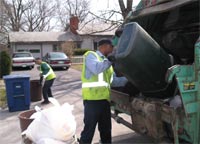Trash Talk
The injuries and fatalities in this industry are largely preventable, and you can help.
 Question:What has four wheels and flies?
Question:What has four wheels and flies?
Answer: A garbage truck. Get it?
Discussion: It’s easy to make light of the solid waste industry,
or, for those above such things, to take it entirely
for granted. The reality, however, is that without it, civilization
as we know it would not last long. And things would get
putrid pretty quickly.
For the men and women involved in the industry—in the United
States, they include about 130,000 workers on the collection side
and another 100,000 or so on the disposal side—it’s a sometimes
thankless job that affords outdoor work, physical activity, a certain
measure of independence, and the satisfaction of
knowing that what they do is important. It’s also a
job with hazards around every corner.
Slow Down to Get Around
Struck-by incidents are high on the list of the industry’s
hazards and getting higher all the time, said
David Biderman, the general counsel and unofficial
safety director for the National Solid Waste Management
Association. “When people are driving down
the street, the garbage collector is this faceless,
anonymous person,” he says. “You may not necessarily
know that there’s going to be a man crossing the
street to get the trash, and you speed up to go
around that garbage truck, and—boom—you run
into him, or you run into the back of the truck because
you’re distracted.Happens all the time.”
It happens so frequently, in fact, that NSWMA
went to OSHA and the Federal Motor Carrier Safety
Administration seeking change and assistance.
Using OSHA grant funding, the association
launched the “Slow Down to Get Around” campaign,
consisting of radio ads that ran in 10 markets
earlier this year and decals emblazoned with
the slogan to place on the bulky fleets. It started
doling out the decals for free at the beginning of
May and by the end of the month had filled 2,000
orders. “This is just the tip of the iceberg,” Biderman
says, noting the association is also offering “state-of-the-art”
training for truck drivers and helpers, initially for free, with the
hope that companies will return for more.
Data from the last two years show the percentage of industry fatalities
from struck-bys is actually increasing, Biderman adds.
“Everybody knows that motorists are a hazard, and everybody
knows it’s getting worse,” he says. “More people have cell phones
and BlackBerrys, and they’re not driving as safely as they should.
It’s an increasing problem, which is why we’re doing all we can to
help reduce the frequency of these things.We want motorists to
think, ‘You know, that’s somebody’s dad up there, that’s somebody’s
brother; maybe I don’t need to speed around a garbage truck at 25
mph.Maybe I need to treat that truck more like a school bus.’”
To further combat the problem, many companies have begun
adding additional lights to the vehicles and painting the trucks’
backs in hi-vis or bright, school-bus yellow. Time will tell if such
measures help decrease struck-bys; meanwhile,
they do nothing for the industry’s leading cause of
fatalities, which is backing incidents. These happen
primarily when the trucks are backing into tight
spaces or cul-de-sacs and the helpers are, despite
their training, riding on the step. “We have developed
a national standard that instructs people not
to be on the step when the truck is going backward,
because if you fall off at that point, you’re
going to end up under the wheel,” which is what
takes place way too often, Biderman says.
Monster Trucks
Another important and too-frequent hazard in the
industry involves workers’ failure to perform proper
lockout/tagout procedures during maintenance
and cleaning. “Everybody in the solid waste business
knows that these trucks are dangerous, that
you have to do more than just take the key out. But
some people don’t even take the key out,” Biderman
says. “Sometimes it’s a matter of the truck not
working properly, and the guy tries to fix it. He
doesn’t lock out and tag out the equipment, and he
inadvertently starts the thing, and he falls and gets
smushed. People forget their training in the heat of
the moment and—boom. These incidents drive me
absolutely crazy because they’re preventable.”
The frustration Biderman expresses is no doubt
a form of “crazy” to which many safety professionals can relate,
but at the end of the day it’s clear he has every bit as much respect
for the workers he represents as anguish over those who never
make it home from their shift.
“Look, it takes a certain type of person to want to do this
kind of work,” he says. “But if you interview most garbage men
or you listen to them every day, like I do, you see that they’re
very proud that they’re garbage men. And, really, they should be,
because without them, where the hell would we be?”
This article originally appeared in the August 2008 issue of Occupational Health & Safety.